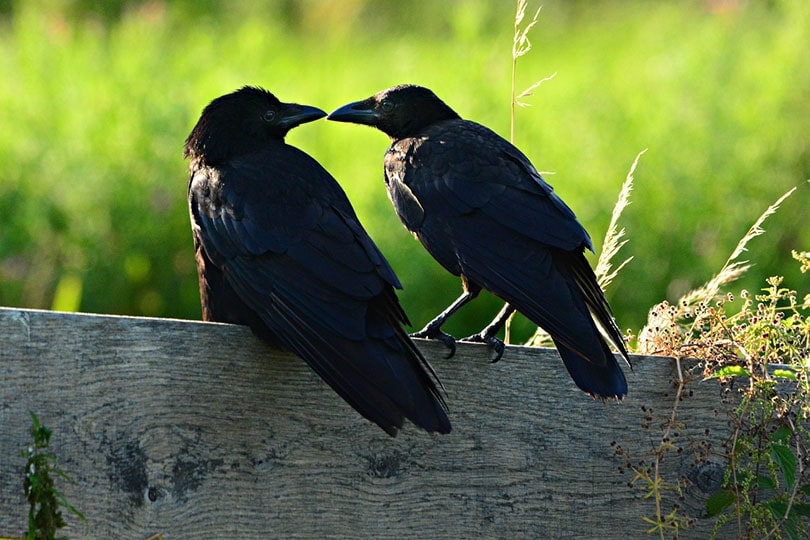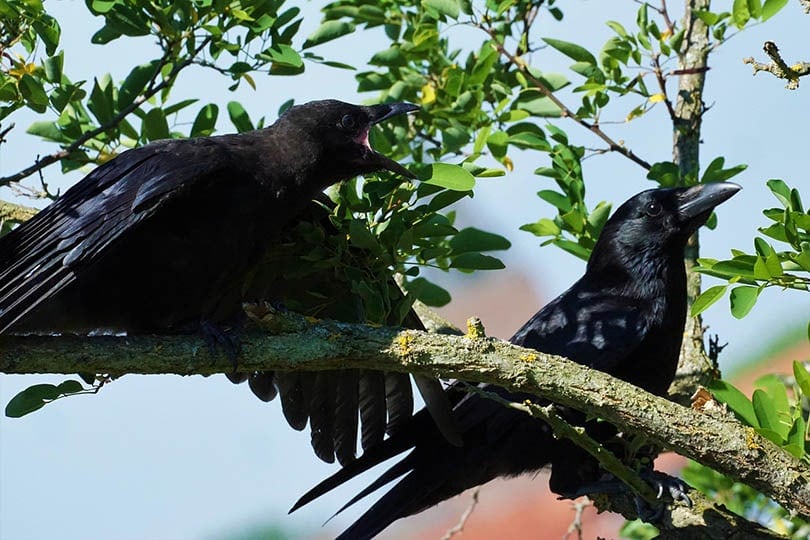Do Crows Mate for Life? Fun Crow Mating Facts!
Last Updated on

Crows are known to be social birds, even going as far as hanging out in groups (known as a “murder”!). Beyond their gossipy tendencies and their intelligence helping them solve all manner of puzzles, not many people know much about crows’ family lives. Along with being friendly with their flock, crows are primarily monogamous and mate for life.
Unlike other bird species, after courting and successfully mating, crows will build a nest together, incubate the eggs, and take care of their young as a team. The following year, they’ll repeat the process all over again until one of the pair dies or is no longer able to breed.
It’s not just the mated pair that take care of each other, though; offspring from the previous year’s mating season will also take care of their parents. They’ll feed the female crow as she incubates her eggs and will also help protect their newly hatched siblings.

How Long Do Crows Live?
Knowing that crows are monogamous, you’re probably wondering how long “life” is for a crow. American Crows can live anywhere between 13 to 20 years, depending on whether they live in the wild or are bred in captivity. They’re often confused with ravens, who can live much longer.
Depending on their age when they meet their partner, the length of time that a crow is part of a mated pair can vary. In general, female crows mature faster than males. They’ll reach sexual maturity at 3 years old, while the males will fully mature at 5 years of age.

Do Crows Mate More Than Once?
Although they’re mostly monogamous birds, there are times when crows reach beyond their partner. This can happen if their first partner dies or becomes infertile due to stress or some other health reason. In these cases, you’ll find that both crows in the original mated pair — or only one, if the other died — will search for another mate to build a family with.
There are also cases of promiscuity, especially when the male is injured and less likely to sire large nests or be able to properly protect his mate. While she won’t abandon him, she’ll also be more likely to look for other partners.
Do Crows Return to the Same Nest Every Year?
With their reliance on family and supporting each other, it isn’t surprising that crows will return to the same nesting site year after year. They’ll work together to build their new nest and settle in to raise another family.
They’ll also gravitate to the same areas where they were born and raised. Crows that grew up in woodland areas will prefer finding a similar place to build their own nest instead of open fields or a city park and vice versa. As a result, the style of their nests can vary. They’ll either be 15–60 feet above the ground or located in low hedges or shrubbery. They’ve even been known to perch on windowsills if there’s nowhere else available and it’s far enough away from predators.
Interestingly, when crows leave their nest for the year, their uninhabited home will be commandeered by hawks or owls.

How Long Do Crows Stay With Their Parents?
Family-oriented as they are, crows don’t chase away their young when they reach maturity. While other bird species may never see their parents, young, or mates once the breeding season is over, crows will stay with their family units.
They’ll also visit even after finding their own partners and starting their own family unit. The offspring of one mated pair will sometimes return to help raise their siblings or just to say hello.
What Are “Communal Roosts”?
Along with being family-oriented, crows will also raise their young as part of a larger group, especially during the cold winter months. After the nesting season and when the young are old enough, the family will join a communal gathering of crows. Unlike the smaller families, which average at about 15 birds, communal groups can be much larger and contain hundreds of crows, if not more.
These “communal roosts” give younger, inexperienced birds a chance to learn from their elders and find mates. These also give them the chance to explore within the safety of the roost without being limited to only seeing their parents and siblings.

Summary
Crows are highly intelligent and fond of their family members. Unlike other birds, they’ll return to their bonded partner year after year to raise their young together, often in the same location as previous nesting seasons.
They don’t chase away their young once they’re matured either. Instead, their offspring will help tend the new nest and keep watch over their siblings.
Not all crows are strictly monogamous, though. While they will form tight bonds with their family members and their mate, there are times when searching further afield for another partner is necessary. This can happen due to the death of one of the mated crows, a debilitating injury, or an unsuccessful breeding season.
Featured Image Credit: MabelAmber, Pixabay
About the Author Robert Sparks
Robert’s obsession with all things optical started early in life, when his optician father would bring home prototypes for Robert to play with. Nowadays, Robert is dedicated to helping others find the right optics for their needs. His hobbies include astronomy, astrophysics, and model building. Originally from Newark, NJ, he resides in Santa Fe, New Mexico, where the nighttime skies are filled with glittering stars.
Related Articles:
How to Clean a Refractor Telescope: Step-by-Step Guide
How to Clean a Telescope Eyepiece: Step-by-Step Guide
How to Clean a Rifle Scope: 8 Expert Tips
Monocular vs Telescope: Differences Explained (With Pictures)
What Is a Monocular Used For? 8 Common Functions
How to Clean a Telescope Mirror: 8 Expert Tips
Brightfield vs Phase Contrast Microscopy: The Differences Explained
SkyCamHD Drone Review: Pros, Cons, FAQ, & Verdict
